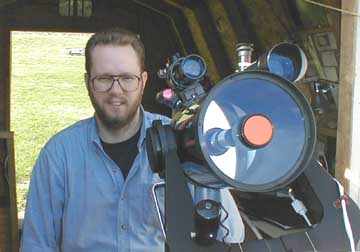Big Woodchuck Solar Observatory!

"Solar Observing":

For thousands of years, man has been interested in the Sun for various reasons.
The Sun's held a special place in all of the early civilizations. Most of the early
people worshipped the Sun in one way or another; The sun god "RA" of the ancient
Egyptians, 'Apollo' and his sun chariot of the Greeks, the rulers of the Incas,
and the Aztecs, divine descendants from the sun.
But as people became more knowledgeable of the sky and the various cycles & phases
that the sky objects go thru, the Sun slowly lost it's religious importance.
Around the 4th century BC, ancient Chinese and South American astronomers began
making recorded observations of the Sun. They noticed that during sunrise or sunset,
they occasionally would see dark markings or spots on the sun.
This was the first recorded observation of sunspots,and was pretty much the extent of
our observational knowledge about the Sun until after the invention of the telescope.
Modern Solar astronomy began in 1610 when Gallieo used his telescope to observe
the Sun, and 'discovered' sunspots. As the telescope was improved over the centuries,
(and more recently with space based satellite instruments), many important discoveries
and theories were made, leading up to our present day knowledge of the Sun and
how it works.
The Sun is made up of mostly hydrogen and helium gas, with traces of other elements.
It's about 865,000 miles in diameter. (Earth is about 7,600 mile, about 110x smaller).
The Sun weighs about 330,000 more than the Earth, and takes about 25 - 35 days to
make one rotation.
Because of the Sun's giant size & weight, the force of gravity is so strong at the
center that the hydrogen gas atoms are crushed together and creates nuclear fusion.
This nuclear reaction causes the surface of the sun to be very hot (about 10,000 F).
At the Sun's core, the temperature soars to about 25,000,000 F.
This is what creates all the light, heat, and energy that comes from the Sun.
One of the main reasons that I like to observe the Sun, is that it's one of the few
astronomical objects that can have a real physical affect on us.
Beyond the obvious, in which the Sun supplies us with heat, light, energy, & life,
there are some lesser known but important affects caused by radiation from the Sun
and solar flares hitting the Earth's atmosphere and magnetic field.
These are called 'Solar-Terrestrial' effects. (electromagnetic and geomagnetic).
The most common is the Aurora or 'northern lights', but also includes:
- Radio, TV, and cellular phone interference.
- Disruption of power systems (brownouts).
- Static electricity buildup on pipelines.
- Satellite and spacecraft electrical malfunctions.
- Radiation danger to astronauts.
- Possible long-term weather & climatic changes.
- Possible radiation threat to plant & animal life via ozone depletion.
Observing the Sun can be an interesting activity for amateur astronomers.
It is also one of the few areas where amateur's can contribute scientific data to
professional astronomers. (thru counting and tracking sunspots).
Because of the Sun's brightness and size, even a small telescope will show plenty of
detail. The solar features change from day to day, and is fun following them as they
rotate across the Sun. It's exciting to observe the appearance of a giant sunspot group
moving around the edge of the Sun, or see a large loop prominence arching over the
solar limb.
Warning: Never look at the Sun thru a telescope without a solar filter!
Permanent eye damage WILL occur!
There are two ways to safely observe the Sun with your telescope.
1) - Projection. (project an image of the sun onto a flat surface).
2) - Aperture Filter. (use a solar filter on the front of the telescope).
Never use a "eyepiece" type solar filter. These will shatter from the heat.
The type of solar feature that you can observe depends on the type of solar filter:
White-light (standard) solar filters: (can be either glass or mylar). *
- Sunspots: Slightly cooler & darker areas on the Sun's surface.
Caused by intense magnetic fields that partly block the flow of energy.
Form in polar regions and slowly migrate down to the equatorial regions.
Last anywhere from a few days to over a month.
Usually form as a single small spot, but can grow to form a large complex
group larger than the Earth.
- Faculae: Bright clouds of hydrogen gas floating above the Sun's surface.
Mark areas where sunspots may be forming, or where sunspots have decayed
and disappeared.
- Photosphere: This is the Sun's visible surface.
About 300 miles thick with a temperature of about 10,000 F.
Has a grainy appearance in white-light, but shows much more detail
in h-alpha light.
* can also see these features using projection.
H-alpha solar filters: (consist of a specialized pre-filter and post-filter).
- Prominences: Giant arcs of hydrogen gas that can be thousands of miles long and high.
Their shapes are determined by the Sun's magnetic field.
- Flares: Giant explosions of radiation, and energy that breaks away from the Sun.
Usually come from large complex sunspot groups.
Can cause affects on the Earth.
Recommended Readings:
"Complete Manual of Amateur Astronomy" P. Clay Sherrod
"Observing the Sun" Peter Taylor
"How to Observe the Sun" Astronomical League
"Solar Astronomy Handbook" Rainer Beck
"AstroPhysics of the Sun" Harold Zirin
You may E-MAIL me at:lsmch@comcast.net
go to: Top of Page:
return to: BWSO:
This is it. Hope you enjoyed the visit. Come again soon!


